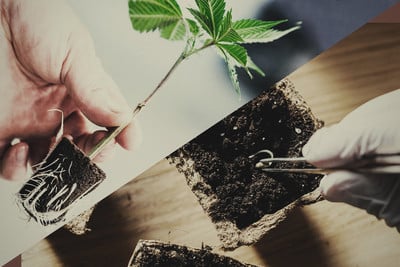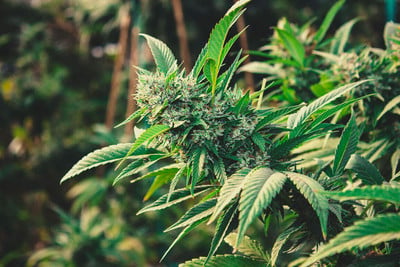Cannabis Hermaphroditism: What Is It, And How Can You Deal With It?

Do you think you might have a “hermie” threatening to ruin your entire harvest? If so, you’ll need to act fast. In this article, we’ll teach you everything crucial about hermaphroditism in cannabis plants, including how to spot it, deal with it, and prevent it in the future.
Contents:
What is Hermaphroditism?
A "hermie" is a marijuana plant that has both female and male flowers. Cannabis is a dioecious plant species. Unlike other flowering plants, it produces different males and females. However, cannabis can also be hermaphroditic, producing a single plant with both male and female sex organs.
What Causes Hermaphroditism?
There are a number of different causes of hermaphroditism in cannabis plants. These include:
• Genetics
Sometimes, cannabis plants can inherit hermaphroditic genes. This can occur naturally or as a result of breeding, the stress of which can introduce hermaphroditism into a strain.
• Seed manipulation
The poor handling and manipulation of seeds can also increase the chances of a plant being hermaphroditic. This can include feminization, an unnatural process used by seedbanks and breeders to guarantee a high percentage of female plants in their seeds. Done correctly, feminization will only produce female plants. Done poorly, some hermaphrodites can occur.
• Stress
Plants naturally seek out environmental conditions that allow them to grow healthy and strong. When those conditions aren’t met, they suffer from stress. For cannabis, this stress can push a plant to become hermaphroditic.
Hermaphroditism as a Survival Instinct
In order to better understand hermaphroditism in cannabis plants, it’s important to realise that, in some cases, hermaphroditism is a survival mechanism.
The whole production of sinsemilla cannabis is very unnatural. It takes female cannabis plants and forces them to go unfertilised for extremely unnatural amounts of time. This is essentially what forces the plant to rev up its production of THC and terpenes, giving us the extremely potent and aromatic buds we seek.
And that’s not to mention the many training techniques that cannabis growers use to manipulate their plants, pushing them to produce bigger yields. Even breeders use unnatural techniques (such as inbreeding) to produce their seeds and create strains that are extra potent, high-yielding, and homozygous.
Now, is this good or bad? Well, that’s an interesting topic that unfortunately lies far outside the scope of this article. For the purpose of this read, it’s simply important that you realise that cannabis cultivation isn’t exactly “natural”, and that this can influence why some plants turn out hermaphroditic.

What Kind of Stress Can Cause Cannabis Plants to Become Hermaphroditic?
There are many ways to stress cannabis plants. These include:
• Temperature and humidity
Cannabis plants naturally like temperatures of around 20–30°C and relative humidity of 40–70%. If the temperature or humidity of your grow room is too far out of these ranges, this can be enough to turn your plants into hermaphrodites.
• Lighting
As you probably know, lighting is super important for cannabis plants. If your plants are too close to their light source, or your lighting schedules are all over the place, this can also stress your plants. Light leakage during dark periods is also a big stressor and should be addressed immediately.
• Nutrients
Cannabis plants need the right nutrients to produce great bud. Over/underfeeding can stress your plants, affecting their ability to develop properly and potentially increasing the risk of becoming hermaphroditic.
• pH
Using a growing medium that is too acidic or alkaline is another big stressor for cannabis.
• Poor growing medium
Your growing medium houses your plants' roots, helping them absorb nutrients and water. A poor growing medium can cause root problems, which, you guessed it, causes stress for your plants.
• Poor training techniques
Training techniques like fimming, topping, LST, super cropping, and countless others work by stressing cannabis plants in a good way, encouraging them to take up more nutrients, or grow in a specific way that can help improve yield. When done incorrectly, however, these techniques can affect a plant negatively.
• Long flowering times
Sometimes, female plants that have gone long stretches of time without pollination can start to produce pollen in an effort to self-fertilise.
Remember, plants need a specific set of conditions met in order to grow and develop properly, and cannabis is no different. When we grow weed, especially indoors, we’re responsible for meeting these conditions. We also walk a fine line of pushing our plants and manipulating them in ways that benefit us in terms of higher yields, more potent and flavourful bud, and more.
Getting this wrong can result in stress for our plants, which in turn may push them to become hermaphroditic, especially if the plant we’re growing already has a genetic disposition to hermaphroditism.

How to Spot a “Hermie”
A hermaphrodite cannabis plant can destroy an entire harvest of cannabis buds by releasing pollen into your grow room and fertilising your females. When this happens, females will focus their energy on producing seeds rather than big, resinous buds.
Hence, it goes without saying that you need to catch any hermaphrodite plants as quickly as possible. Some plants will show signs of hermaphroditism early on when they just start producing flowers. You’ll see these plants developing both male and female flower structures. These can form on different branches or on the same branch, and some hermaphrodites even develop both structures at the same bud site. These are called “true hermaphrodites”.
Alternatively, some plants may become hermaphroditic toward the end of their bloom cycle. This can be the result of a plant trying to make one last attempt at pollinating itself before dying. Thus, while many growers tend to become a lot more hands-off during the bloom cycle, it's important to regularly check on your plants and keep an eye out for hermaphroditic flowers during this final stage of life.
Plants that turn hermaphrodite late in the bloom phase usually develop what some growers call “bananas”. This is the male stamen (exactly like those you’d find inside a male pollen sac), which has protruded through the female flower and can release pollen at any moment. Technically speaking, these are mixed-sex buds, rather than true hermaphroditic plants.
How to Deal With Hermaphrodite Cannabis Plants
True hermaphrodites, like male plants, need to be culled early to avoid having them pollinate your other females. Plants with mixed-sex buds, on the other hand, can be harvested.
If one of your plants has produced “bananas” toward the end of its bloom phase, you may want to consider harvesting the plant and keeping its buds, which should still be seedless. Depending on how far along your plant was, they may still produce a perfectly fine smoke.
How to Prevent Hermaphrodite Cannabis in the Future?
Unfortunately, there’s no telling whether a plant has hermaphroditic genes. The only thing you can do to prevent hermaphroditism is this: give your plants the best possible growing conditions and avoid stressing them at all costs. If you use training techniques (both low and high stress), make sure you know what you’re doing.
Finally, always make sure you buy your seeds from a reputable cannabis seedbank whose breeders do their best to minimise hermaphroditism when breeding new strains.







































